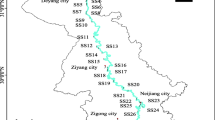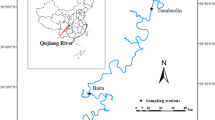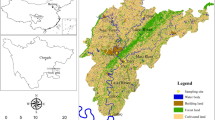Abstract
Characterizing water quality and identifying potential pollution sources could greatly improve our knowledge about human impacts on the river ecosystem. In this study, fuzzy comprehensive assessment (FCA), pollution index (PI), principal component analysis (PCA), and absolute principal component score–multiple linear regression (APCS–MLR) were combined to obtain a deeper understanding of temporal–spatial characterization and sources of water pollution with a case study of the Jinjiang River, China. Measurement data were obtained with 17 water quality variables from 20 sampling sites in the December 2010 (withered water period) and June 2011 (high flow period). FCA and PI were used to comprehensively estimate the water quality variables and compare temporal–spatial variations, respectively. Rotated PCA and receptor model (APCS–MLR) revealed potential pollution sources and their corresponding contributions. Application results showed that comprehensive application of various multivariate methods were effective for water quality assessment and management. In the withered water period, most sampling sites were assessed as low or moderate pollution with characteristics pollutants of permanganate index and total nitrogen (TN), whereas 90 % sites were classified as high pollution in the high flow period with higher TN and total phosphorus. Agricultural non-point sources, industrial wastewater discharge, and domestic sewage were identified as major pollution sources. Apportionment results revealed that most variables were complicatedly influenced by industrial wastewater discharge and agricultural activities in withered water period and primarily dominated by agricultural runoff in high flow period.




Similar content being viewed by others
References
Chen, H. W., Chang, N. B., & Shaw, D. (2005). Valuation of in-stream water quality improvement via fuzzy contingent valuation method. Stochastic Environmental Research and Risk Assessment, 19(2), 158–171.
Chen, H. Y., Teng, Y. G., & Wang, J. S. (2012a). Load estimation and source apportionment of non-point source nitrogen and phosphorus based on integrated application of SLURP model, ECM and RUSLE: a case study in Jinjiang River watershed, China. Environmental Monitoring and Assessment. doi:10.1007/s10661-012-2684-z.
Chen, H. Y., Teng, Y. G., & Wang, J. S. (2012b). Source apportionment of polycyclic aromatic hydrocarbons (PAHs) in surface sediments of the Rizhao coastal area (China) using diagnostic ratios and factor analysis with nonnegative constraints. Science of the Total Environment, 414, 293–300.
Chen, H. Y., Teng, Y. G., Wang, J. S., & Song, L. T. (2012c). Source apportionment of water pollution in the Jinjiang River (China) using factor analysis with nonnegative constraints and support vector machines. Environmental Forensics, 13(2), 175–184.
CN-EPA (2002). National Environmental Quality Standards for surface waters, China (GB3838-2002), Chinese Environmental Protection Agency.
Fharnham, I. M., Singh, A. K., Stetzenbach, K. J., & Lohannesson, K. H. (2002). Treatment of nondetects in multivariate analysis of groundwater geochemistry data. Chemometrics and Intelligent Laboratory Systems, 60, 265–281.
Goldhaber, S. B. (2003). Trace elements risk assessments: essentiality vs. toxicity. Regulatory Toxicology and Pharmacology, 38, 232–242.
Guleda, O. E., Ibrahim, D., & Halil, H. (2004). Assessment of urban air quality in Istanbul using fuzzy synthetic evaluation. Atmospheric Environment, 38(23), 3809–3815.
Guo, H., Wang, T., & Louie, P. K. K. (2004). Source apportionment of ambient non-methane hydrocarbons in Hong Kong: application of a principal component analysis/absolute principal component scores (PCA/APCS) receptor model. Environmental Pollution, 129, 489–498.
Huang, F., Wang, X., Lou, L., Zhou, Z., & Wu, J. (2010). Spatial variation and source apportionment of water Pollution in Qiantang River (China) using statistical techniques. Water Research, 44(5), 1562–1572.
Hulya, B., & Hayal, B. (2008). Water pollution sources assessment by multivariate statistical methods in the Tahtali Basin, Turkey. Environmental Geology, 54(2), 275–282.
Jonnalagadda, S. B., & Mhere, G. (2001). Water quality of the Odzi River in eastern highlands of Zimbabwe. Water Research, 35, 2371–2376.
Kannel, P. R., Lee, S., & Lee, Y. S. (2008). Assessment of spatial–temporal patterns of surface and ground water qualities and factors influencing management strategy of groundwater system in an urban river corridor of Nepal. Journal of Environmental Management, 86(4), 595–604.
Leeuwen, F. X. R. V. (2000). Safe drinking water; the toxicologist’s approach. Food and Chemical Toxicology, 38, 51–58.
Lu, R. S., & Lo, S. L. (2002). Diagnosing reservoir water quality using self-organizing maps and fuzzy theory. Water Research, 36(9), 2265–2274.
Marmur, A., Unal, A., Mulholland, J. A., & Russell, A. G. (2005). Optimization-based source apportionment of PM2.5 incorporating gas-to-particle ratios. Environmental Science and Technology, 39, 3245–3254.
Pekey, H., Karakas, D., & Bakoglu, M. (2004). Source apportionment of trace metals in surface waters of a polluted stream using multivariate statistical analyses. Marine Pollution Bulletin, 49(9–10), 809–818.
Rachdawong, P., & Christensen, E. R. (1997). Determination of PCB sources by a principal component method with nonnegative constraints. Environmental Science and Technology, 31, 2686–2691.
Rowan, J. S., Black, S., & Franks, S. W. (2012). Sediment fingerprinting as an environmental forensics tool explaining cyanobacteria blooms in lakes. Applied Geography, 32, 832–843.
Shrestha, S., & Kazama, F. (2007). Assessment of surface water quality using multivariate statistical techniques: a case study of the Fuji river basin, Japan. Environmental Modelling and Software, 22(4), 464–475.
Simeonov, V., Stratis, J. A., Samara, C., Zachariadis, G., Voutsa, D., Anthemidis, A., Sofoniou, M., & Kouimtzis, T. (2003). Assessment of the surface water quality in Northern Greece. Water Research, 37, 4119–4124.
Singh, K. P., Malik, A., & Sinha, S. (2005). Water quality assessment and apportionment of pollution sources of Gomti river (India) using multivariate statistical techniques—a case study. Analytica Chimica Acta, 538, 355–374.
Su, S. L., Li, D., Zhang, Q., Xiao, R., Huang, F., & Wu, J. P. (2011). Temporal trend and source apportionment of water pollution in different functional zones of Qiantang River, China. Water Research, 45, 1781–1795.
Wang, H. Y. (2002). Assessment and prediction of overall environmental quality of Zhuzhou City, Hunan Province, China. Journal of Environmental Management, 66(3), 329–340.
Wang, J., Da, L., Song, K., & Li, B. (2008). Temporal variations of surface water quality in urban, suburban and rural areas during rapid urbanization in Shanghai, China. Environmental Pollution, 152(2), 387–393.
World Health Organization (WHO) (2008). Guidelines for drinking water quality. In: Recommendations, 3rd ed., vol. 1, Geneva.
Yuan, Z. W., Ramaswami, B., Casaletto, D., Falke, S., Angenent, L. T., & Giammar, D. E. (2007). Evaluation of chemical indicators for tracking and apportionment of phosphorus sources to Table Rock Lake in Southwest Missouri, USA. Water Research, 41, 1525–1523.
Zadeh, L. A. (1965). Fuzzy sets. Information and Control, 8, 338–353.
Zhou, F., Huang, G., Guo, H., Zhang, W., & Hao, Z. (2007). Spatio-temporal patterns and source apportionment of coastal water pollution in eastern Hong Kong. Water Research, 41(15), 3429–3439.
Acknowledgments
This study was financially supported by the Chinese important special project (No. 2009ZX07419-003) and MOE program of China (NECT-09-0230).
Author information
Authors and Affiliations
Corresponding author
Rights and permissions
About this article
Cite this article
Chen, H., Teng, Y., Yue, W. et al. Characterization and source apportionment of water pollution in Jinjiang River, China. Environ Monit Assess 185, 9639–9650 (2013). https://doi.org/10.1007/s10661-013-3279-z
Received:
Accepted:
Published:
Issue Date:
DOI: https://doi.org/10.1007/s10661-013-3279-z




